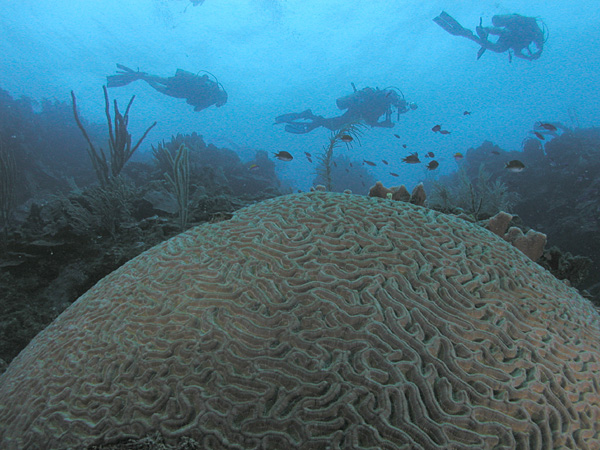- Coral cover in the Mesoamerican Reef is up 10 to 16 percent since 2006, according to a report by the Healthy Reef Initiative.
- Fully protected areas were found to have 10 times more biomass of important commercial fish species like snapper and grouper than regions with little or no protection.
- Only 7 percent of the protected marine areas in the Mesoamerican Reef are under “full protection,” per the report.
An assessment of ecosystem health in the Mesoamerican Reef found that marine protected areas (MPAs) are aiding greatly in its recovery as coral cover slowly expanding.
Coral cover in the Mesoamerican Reef (MAR), which extends across 1,000 kilometers (over 620 miles) of the coasts of Mexico, Guatemala, Belize, and Honduras and supports the local economies relied on by nearly two million people, is up 10 to 16 percent since 2006, a new report by the Healthy Reef Initiative says.
Coral reefs are some of Earth’s most diverse ecosystems, and the Mesoamerican Reef is the largest in the Western hemisphere — but overfishing, both for commercial and subsistence purposes, as well as increased tourism and economic development have put such great pressures on the reef that experts once predicted it might disappear within the next couple decades.
Roatan Marine Park (RMP) is a community-based NGO on the island of Roatán — the largest of Honduras’ Bay Islands, some 50 kilometers (about 31 miles) off the mainland coast — founded in 2005 by local dive operators and businesses who were concerned about the impacts of increased tourism and development on the island’s fragile coral reefs.
Key species that rely on the reef include parrotfish and other herbivorous species that feed on fleshy microalgae, a type of seaweed that competes with coral for space, meaning the reef is almost as dependent on the fish as the fish are on the reef. As a means of protecting these species, Honduras banned spear and trap fishing in all Bay Islands in 2004 and the fishing of parrotfish altogether in 2010.
Honduras was found to have the most of these herbivorous fish, but scored “poor” overall in terms of commercial fish biomass, according to the Healthy Reef Initiative analysis. Roatan was one of the only regions with higher biomass, which the report attributed to “long standing MPA protection, gear restrictions and effective enforcement.”
That effective enforcement is thanks in part to groups like the Bay Islands Conservation Association and RMP, which manage the Sandy Bay-West End Marine Reserve of Roatán island.
RMP was originally established to patrol the reserve, but today, in addition to acting as co-manager, the group also works with the local community as an important aspect of its conservation efforts. Running environmental education programs and public awareness campaigns, restoring mangroves, and performing environmental impact assessments of proposed developments on the island are all part of the job.
Giaco Palavicini, the Executive Director of Roatan Marine Park, told Mongabay that all of these efforts “are essential to reduce the gaps between the community and us,” not only helping to inform the public about the importance of conservation measures, but enlisting the community’s help in those efforts, as well.
But patrolling the reserve is still one of the main activities of the group. “Every day we encounter minor situations where people fish small lobster or conch to feed themselves or their families and they get warnings,” Palavicini said, “but when we get big scale poachers with product numbers higher than the ones you need to feed a family and they show no compliance they are sent to the police and a report is filed.”
The consequences for these poachers range from a fine to jail time, “depending on the level of the offense,” he added.
Some 45 protected areas have been established in the Mesoamerican Reef, encompassing more than 23,000 square kilometers (about 8,880 square miles) — but simply establishing a protected area is not enough. Other measures, like bans on fishing for crucial species and on using specific fishing gear, have proven to be important tools to help conserve coral reef.
Only 7 percent of the protected marine areas in the Mesoamerican Reef are under “full protection,” per the Healthy Reef Initiative, which found that fully protected areas had 10 times more biomass of important commercial fish species like snapper and grouper than regions with little or no protection.
“Given the projected long recovery periods expected for coral reef ecosystems, even within MPAs,” the authors of the report wrote, “implementing additional fishery restrictions can complement and improve the effectiveness of marine protected areas.”




